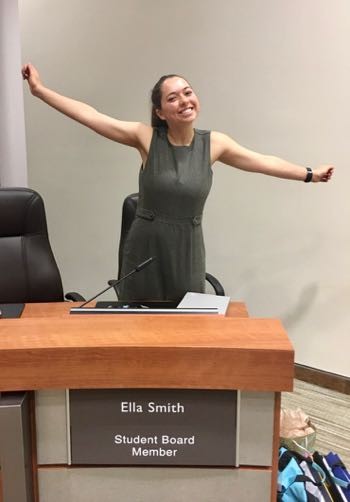What Student Board Members Should Know Before They Start

by Ella Smith
Editor's note: Many school boards in California include a student member. We invited Ella to comment on her experiences as the student member on the board of Poway Unified School District. Ella will be attending UC Berkeley in the coming school year.
As I finish my term as the Student Board member on the Poway Unified School District Board of Education, I finally understand why my predecessor kept expressing how much there is to learn through this position.
Like many student board members, I began my term knowing that I was passionate about advocacy and serving my community, but I was considerably unaware of how a school district functions and what to expect.
You aren't alone!
Many school boards in the state of California include a student member -- usually a 12th grader who applied, interviewed, and was eventually appointed by their district's Board of Education, or by an appointed subcommittee. They usually serve for a year-long term alongside the elected Board Members. Student members participate in discussion, and offer their "preferential" vote on some agenda items. With a preferential vote, the student's vote is recorded in the Board Meeting minutes, but does not affect the final outcome of a voting item.
At the state level, however, California's Governor appoints a rising senior to serve on the California State Board of Education for a one-year term. In 1983, the student member gained full voting privileges (including during closed sessions).
You can have influence
Nevertheless, a preferential vote is still powerful. When student members are prepared with the knowledge and support they need to serve in the role, they are capable of being changemakers and leaders in the district. There's nothing "token" about it.
There's a lot to know
There is much to learn and little time. Most school board members serve for multiple years. Student board members tend to serve for just one. Here is what I wish someone had told me coming into the role:
 Ella Smith
Ella SmithYou will be confused. And that's okay! There will certainly be rules you have not heard of and acronyms galore (LCAP - what AP class is that?) ... it's easy to sit through a Board meeting and feel lost. The meeting often goes by fast and asking questions can be intimidating. However ...
It's okay to ask questions. Your questions might illuminate information to community members in the audience, watching the livestream (if your district has one), or reading the minutes from the meeting. If you don't know what LCAP stands for, ask! Your question can lead you to make valuable contributions to the discussions. And whether your role is to offer a student's perspective or to cast a preferential vote, understanding what's at hand is critical.
But you need to know your stuff. Learning about the education system, what's happening in California's schools, and all of that can be daunting, but thankfully, Ed100 simplifies it. That's why I loved and used this resource so much. Challenge yourself to complete a few lessons each day; each lesson is easy to read and usually takes only a few minutes! Here's a link to get you started.
Think for yourself. Board members may bicker among themselves and even form alliances. Yes, unfortunately cliques exist outside of high school. You should speak for and vote for what's in the best interest of students. But there is a difference between thinking for yourself and listening to others. Your district's staff, your fellow Board members, and your students have valuable contributions -- be sure to listen to them. When you hear different perspectives and do your research, you can much better think for yourself. I applied for the Student Board Member position because I love my school district. Loving my school district did not mean I believed it was perfect. Rather, I was committed to making it better.
You can take the lead. During my term, I saw a critical need for access to free, fresh drinking water on school campuses. So I sought and successfully found grant funding to install hydration stations. I saw a critical need to protect undocumented students and their learning, so I advocated for a Safe Haven Resolution, which passed in my district. Representing students means more than reporting what's happening at school sites. You can solve problems and seek avenues for action on a handful of pragmatic goals. You'll succeed best if you work with a team including teachers, district personnel, your superintendent, other students, and/or other stakeholders.
Learn to work in a team. Working with others (and for them) can be challenging. Working by yourself can be much easier than working with others or with a team. But as one of my favorite proverbs goes: If you want to go fast, go alone; if you want to go far; go with others. Board of Education members need to know that this is not about them; it's about making sound decisions for students. Put personal disputes aside; whether you want to promote making schools safe for learning or teach PTAs in your district how they can win $1,000 be ready to go further with a team.
You have supporters. You wouldn't be in this position if it were otherwise. For example, support might come from a teacher, a custodian, an administrator, the receptionist at your district office, or your predecessor. There are people who believe in students; those people are educators for the right reasons. Talk to them. Work with them. Learn from them.
You matter. As the student board member, you see what's happening in classrooms. You are exposed to the diverse needs and opportunities in your district. You are in a unique position to stand up for equity, especially if you get out of your own school and meet students in other sites. You know what students need and desire. You have ideas. Want to make a difference? Give voice to those thoughts and ideas. Vote to represent the needs of students in your district.
Feel honored
The position can be demanding at times, but it is also incredibly rewarding. You will face over-stuffed binders, long meetings and a lot of new homework to prepare and perform the role well. But making a lasting impact in your district is worthwhile for yourself and your district. Serving as the Student Board Member in Poway Unified made me proud to represent and work for something larger for myself. The experience - yes, even with those binders and meetings - was more rewarding than any test score or trophy. My AP credits will let me skip a class here and there at UC Berkeley (Class of 2021 - Go Bears!), but my experience on the school board taught me how to work with purpose, how to lead with humility, and how to make a difference. Like my predecessor said, there is so much to learn. Get ready and get excited to give this the time, energy, and devotion is deserves.
Tags on this post
Leadership School board Student voiceAll Tags
A-G requirements Absences Accountability Accreditation Achievement gap Administrators After school Algebra API Arts Assessment At-risk students Attendance Beacon links Bilingual education Bonds Brain Brown Act Budgets Bullying Burbank Business Career Carol Dweck Categorical funds Catholic schools Certification CHAMP Change Character Education Chart Charter schools Civics Class size CMOs Collective bargaining College Common core Community schools Contest Continuous Improvement Cost of education Counselors Creativity Crossword CSBA CTA Dashboard Data Dialogue District boundaries Districts Diversity Drawing DREAM Act Dyslexia EACH Early childhood Economic growth EdPrezi EdSource EdTech Education foundations Effort Election English learners Equity ESSA Ethnic studies Ethnic studies Evaluation rubric Expanded Learning Facilities Fake News Federal Federal policy Funding Gifted Graduation rates Grit Health Help Wanted History Home schools Homeless students Homework Hours of opportunity Humanities Independence Day Indignation Infrastructure Initiatives International Jargon Khan Academy Kindergarten LCAP LCFF Leaderboard Leadership Learning Litigation Lobbyists Local control Local funding Local governance Lottery Magnet schools Map Math Media Mental Health Mindfulness Mindset Myth Myths NAEP National comparisons NCLB Nutrition Pandemic Parcel taxes Parent Engagement Parent Leader Guide Parents peanut butter Pedagogy Pensions personalized Philanthropy PISA Planning Policy Politics population Poverty Preschool Prezi Private schools Prize Project-based learning Prop 13 Prop 98 Property taxes PTA Purpose of education puzzle Quality Race Rating Schools Reading Recruiting teachers Reform Religious education Religious schools Research Retaining teachers Rigor School board School choice School Climate School Closures Science Serrano vs Priest Sex Ed Site Map Sleep Social-emotional learning Song Special ed Spending SPSA Standards Strike STRS Student motivation Student voice Success Suicide Summer Superintendent Suspensions Talent Teacher pay Teacher shortage Teachers Technology Technology in education Template Test scores Tests Time in school Time on task Trump Undocumented Unions Universal education Vaccination Values Vaping Video Volunteering Volunteers Vote Vouchers Winners Year in ReviewSharing is caring!
Password Reset
Search all lesson and blog content here.
Login with Email
We will send your Login Link to your email
address. Click on the link and you will be
logged into Ed100. No more passwords to
remember!














Questions & Comments
To comment or reply, please sign in .
pscripter June 28, 2017 at 7:37 pm